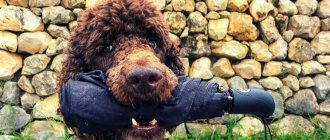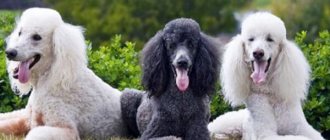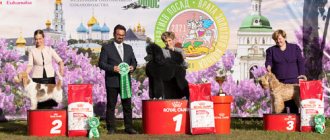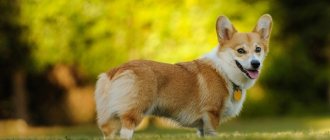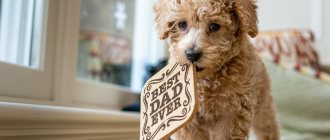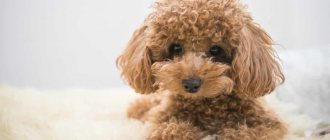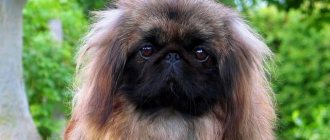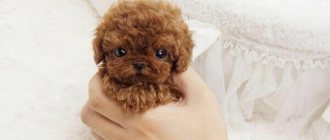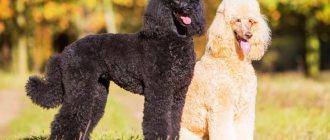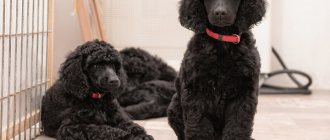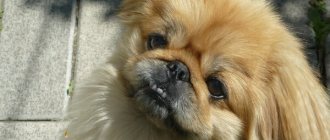Poodles have long attracted animal lovers with their graceful appearance, proud gait and inquisitive mind. The largest representative of this breed, the royal poodle, once belonged only to people from the noble class. These are tall, stately dogs with an unusual hairstyle and luxurious coat. They will become truly worthy companions and will be equally good both as a friend and as a protector.
Breed traits
Breed traits (on a 5-point scale)
| Royal Poodle (Great Poodle) | |||
| Activity | in the house | 3.1 | |
| on the street | 3.6 | ||
| Obedience | training | 4.4 | |
| strangers | 4.5 | ||
| Domination | in family | 1.7 | |
| over dogs | 2.3 | ||
| Defending your territory | from people | 2.4 | |
| from dogs | 2.9 | ||
| Sociability | in family | 4.6 | |
| with strangers | 3.6 | ||
| with dogs | 3.5 | ||
| Concentration | in family | 1.2 | |
| in front of strangers | 2 | ||
| with dogs | 2.1 | ||
| Aggressiveness | in family | 1.2 | |
| to strangers | 1.8 | ||
| to the dogs | 1.9 | ||
| to cats | 2 | ||
| Family behavior | calmness | 4.4 | |
| demand for affection | 4.2 | ||
| excitability | 3.7 | ||
| playfulness | 4.2 | ||
| excessive barking | 3 | ||
| behavioral breakdowns | 2.1 | ||
| Tolerance for children | up to 4 years | 3.9 | |
| over 4 years old | 4.2 | ||
| Institutional use | watchman | 3.8 | |
| bodyguard | 1.6 | ||
This breed is often compared to the following dog breeds: Bichon Frize, Longhaired Collie, Border Collie, Beagle, German Shepherd.
The photo shows what royal poodles look like:
General characteristics of the Royal Poodle breed
Royal poodles are classified as toy dogs based on their appearance only. Their ancestors were hunters, working dogs. Now they are among the smartest breeds. This dog is obedient, reacts almost instantly to his owner’s commands and obeys in 95% of cases.
Poodles like to work and learn. They can learn different tricks and perform in the circus. Nowadays, these beautiful dogs are most often used as companions. But they used to serve as rescuers, and they are especially good at pulling drowning people out of the water. Large poodles helped people in war and hunting. They have a keen sense of smell, they used to look for truffles, now they are sometimes used to search for mines, explosives, drugs, and are used in protective guard duty.
| Options | Characteristic |
| breed name | royal poodle |
| country of origin | France |
| group of breeds according to the ICF classification | ornamental and companion dogs |
| life expectancy | 10-18 years |
| height | male 44-62 cm, female 42-55 cm |
| weight | male 19-25 kg, female 18-23 kg |
| aggressiveness | non-aggressive, friendly |
| activity | high |
| intelligence | very smart, easy to train |
| working qualities | companion, circus dog, hunter |
| care | Difficult coat care, haircut required |
pros
The Royal Poodle is a popular pet and companion all over the world. Despite its large size, it gets along well in a city apartment. The breed has many advantages:
- takes second place in the ranking of the smartest dogs;
- easy to train, they are obedient;
- very loyal and loyal, not prone to dominance;
- treat children well, become attached to them, tolerate all pranks;
- gets along with any pets;
- easily adapt to the owner’s lifestyle;
- no shedding, no dog smell, suitable for allergy sufferers;
- attractive appearance, proud posture;
- by nature they are cheerful, sociable, cheerful, good-natured;
- These pets have good health, and with good care they live a long time.
Minuses
Despite its decorative appearance, the royal poodle is not a sofa dog. They have several disadvantages that may be a problem for some owners:
- they love to bark, the neighbors may not like it;
- these dogs must be cut; an uncut poodle looks very unkempt;
- they are very emotional by nature;
- mobile, need long walks;
- can't stand loneliness
- cunning, able to manipulate the owner;
- can be stubborn.
An interesting video about the breed, the advantages and disadvantages of royal poodles:
Video: Royal Poodle
Video: Royal Poodle - All about the dog breed
Poodle kennels
| Nurseries | Federation | City |
| Hola Nursery | OANKOO/RKK | Pskov |
| Nursery Airi Arabeska | OANKOO/Elite | Moscow |
| Nursery Amagri | RFLS | Moscow |
| Kennel AMVER MELODY | RFOS | Stary Oskol |
| Nursery ATAMI | OANKOO/Fauna | Moscow |
| Kennel Magnificent Poodle | RFLS | Moscow |
| Nursery Graphics Ellanz | OANKOO/RKK | Moscow |
| Kennel Dansing Line | OANKOO/Fauna | Moscow |
| Kennel Gently Born | RFLS | Moscow |
| Nursery Zimaletto | RFLS | Moscow |
| Kennel Iz White flock | OANKOO/Fauna | Moscow |
| Nursery from the City of Catherine | OANKOO/Elite | Ekaterinburg |
| Nursery IZ ZELENOY BOR | OANKOO/RKK | Kazan |
| Nursery Iz Winter Dreams | RFLS | Lyubertsy |
| Kennel FROM KAZAN KHANSVA | RFSS | Kazan |
| Kennel FROM THE COUNTRY OF SNOW | RFSS | Severodvinsk |
| Kennel Empire Viktel | RFLS | Orekhovo-Zuevo |
| Kennel CAUCASIAN PRISONER | RFSS | Domodedovo |
| Kennel KENLINE | RFSS | Chastsy |
| Kennel Constanta Ross | OANKOO/Fauna | Moscow |
| Kennel Krona Style | RFLS | Arkhangelsk |
| Kennel Luxury Star | RFLS | Tambov |
| Kennel LEGGERO DANZATORI | RFSS | Yaroslavl |
| Nursery MALISH AND CO | RFSS | Saint Petersburg |
| Kennel My Variation | RFSS | Moscow |
| Nursery Tenderness of Love | OANKOO/Elite | Moscow |
| Kennel OLIMP UPPERCUT | RFLS | Kemerovo |
| Nursery OT ZOLOTO POBYO | RFSS | Moscow |
| Kennel FROM THE GRAY CARDINAL | RFLS | Saint Petersburg |
| Kennel Ocean of Time | RFLS | Moscow |
| Kennel Peter Ulybok | RFLS | Saint Petersburg |
| Nursery Ravissant | OANKOO/RKK | Noginsk |
| Nursery S ZOLOA GORA | RFSS | Izhevsk |
| Kennel S KONCHURY | RFOS | Sergiev Posad |
| Nursery From Lipetsk Sloboda | OANKOO/Fauna | Lipetsk |
| Nursery S PLANET OF DREAMS | RFLS | Moscow |
| Nursery FROM THE MYSTERIOUS ISLAND | RFSS | Ozersk |
| Nursery NORTHERN STYLE | RFSS | Arkhangelsk |
| Nursery Smart Connection | OANKOO/RKK | Moscow |
| Nursery SNOW LAPLAND | RFLS | Murmansk |
| Kennel Black Kurazh | RFLS | Murmansk |
| Nursery CHINSHOU | RFLS | Novorossiysk |
| Nursery Evak's | OANKOO/Elite | Saint Petersburg |
Source - https://rkf.online/organizations?organization_type=3&active_rkf_user=false&activated=false
For more information, see the official website of the RKF.
Origin story
Images of dogs with an elongated muzzle and curly hair date back to antiquity. Archaeologists have found them on Roman and Greek coins and cathedral walls. But France became the birthplace of the breed. This country calls her a national treasure. Although the Germans claim that the breed originates from Germany.
Researchers have not reached a consensus on which breeds poodles originated from. At first they were used for hunting ducks; this dog swims well. But they could do different jobs: protect, herd sheep. A common version is that the breed was created by crossing German sheep poodles and Spanish water dogs. The name suggests this: pudel is a German word that translates as “splash in water.” Many researchers note the kinship of representatives of the breed with pointers, commanders, spaniels, and barbets.
Gradually, poodles became popular among the nobility; only members of royal families were allowed to own these dogs, hence the name of the breed. But there is a version that they were named royal by King Charles, who was saved by such a dog during the English Revolution. And some believe that they call poodles royal because of their aristocratic, proud posture and luxurious coat.
These dogs were often used in traveling circuses, they served as guide dogs and helped hunters. Thanks to their high stature, they could be good defenders and rescuers.
The first description of such dogs appeared back in 1555. Already at that time, three varieties were identified: large, small and dwarf. But the first standard was developed in the 30s of the 20th century. The Great Royal Poodle received official recognition from the International Film Festival only in 1984. This variety has been identified as a separate breed. Sometimes such a poodle is also called standard, in contrast to small and dwarf.
Origin
Today, poodles are commonly thought of as toy or show dogs. When the breed is mentioned, people usually think of the small variety or miniature toy poodles. However, previously the large royal poodle was a companion of trappers and was distinguished by excellent hunting qualities. The development of this breed took place mainly in Germany and France. Breeders in the two countries argued for a long time about who would have the right to poodles. In the end, France won. It was their description of the breed that was first included in the international register and later translated into other languages.
Description of the appearance of large royal poodles
Royal Poodles have a harmonious build and are above average in height. According to the standard, the height at the withers is allowed from 45 to 62 cm; in females the size is slightly smaller. The body is elegant, graceful, representatives of the breed usually weigh 23-25 kg. But they are prone to obesity, so you need to ensure that the dog’s weight does not exceed 30 kg.
Head
The head is proportional in size to the body. The back of the head is rounded, the tubercle is well defined. The muzzle has an elongated shape, tapering towards the nose, slightly shorter than the skull. The stop is smooth, the bridge of the nose is straight, the nostrils are wide. Preferably black, but white dogs can be brown. The teeth are strong, scissor bite. The upper jaw overlaps the lower jaw. The lips are dense, thin, tightly closed, black in color. Brown and red individuals may have lighter colors.
The eyes are medium-sized, almond-shaped, set straight. The color is dark brown, in brown dogs it is amber. The look is smart, attentive. The ears are soft, small, and rounded at the ends. They hang tightly to the head, but are very mobile.
Frame
The body is rectangular - the height at the withers is slightly less than the length. The muscles are well developed, but dry and not very pronounced. Bitches are built more gracefully. The neck is long, elegantly arched, the chest is oval, deep, the belly is moderately tucked. The back is straight, the withers are pronounced. The loin is convex, muscular, the croup is slightly rounded.
The tail is set high, of medium length, covered with hair. An excited dog lifts it up and bends it into a half ring; in a calm state it is lowered. In the past, the tail was often docked.
Limbs
The limbs are straight, set parallel. The shoulder blades are sloping, the elbows are high. The thighs are muscular, the hock joints are well defined. The paws are oval, the toes are pressed tightly together. The claws are black; white individuals may have light ones. The gait is light, free, springy. The dog moves as if dancing.
Wool
The skin of these dogs is smooth, tight-fitting, and does not gather in folds. The fur is fluffy and long. According to the characteristics of the coat, two types are distinguished: curly and corded. In the former, the wool is pleasant to the touch, soft, curls, and has a springy structure. This protects it from the formation of tangles, but in uncut dogs it gets stuck together.
The Corded variety is sometimes classified as a separate breed. Their fur is thick, coarse, and thin hairs are curled into cords. Length more than 20 cm.
Colors
The standard allows only solid colors of royal poodles; there should be no spots:
- black;
- white;
- brown;
- gray or silver;
- different shades of red - red, apricot, peach, fawn.
The dog's skin is colored depending on the color of its coat: red, black, gray or brown. White individuals should have silver. The RKF and AKC standards recognize two more colors: white and black, such dogs are called harlequin, and black and tan (phantom).
The photo complements the description of the appearance of representatives of this breed:
Disqualifying Faults
The standard clearly defines the appearance of dogs. Any deviation may be grounds for disqualification and exclusion from breeding. Vices include:
- arched or sunken back line;
- tail set low or carried over the back;
- very pointed muzzle;
- partially pigmented nose and lips;
- big eyes;
- short ears;
- hard or sparse coat;
- uneven color, faded or spotted;
- height over 62 cm.
Description of the breed
The dog is well proportioned, its weight is 20-23 kg. The standard size of a poodle is 45-58 cm, but can reach greater heights.
The breeds are divided into two varieties based on coat type: corded and curly. The first is sometimes mistakenly classified as a separate type of dog due to the non-standard structure of the hair, twisting into cords.
Royal poodles are characterized by the following external features:
- Head with a slightly protruding forehead, smooth transition from forehead to muzzle, straight nose.
- The lips are of medium thickness, sometimes with pinkish spots on the premolars. The extreme line of the lips is pigmented.
- Teeth are medium sized, white. The rows are even, the bite is scissor.
- The nose is black, well developed. It is characterized by mobility and is completely covered with pigment.
- The eyes are straight, small, almond-shaped. The color is brown of varying degrees of saturation, but dark is more valued.
- The ears hang on soft cartilage and are rounded at the ends. In moments of alertness, they may lean forward slightly.
- The body is without folds and resembles a rectangle. Well-developed muscles, tight-fitting skin.
- The neck is medium in length and bends well. Moves to the withers.
- The back is straight, the lower back is slightly convex. The stomach and groin are toned, which emphasizes the athletic physique.
The tail is without bends, docking is possible. Located at a high altitude.
Colors
For poodle breeders, it is preferable for the pet to have a solid color, as this is a characteristic feature of the breed. There are black and tan and white and black dogs, but they are not recognized by the International Canine Federation and are considered a color defect. Among the solid colors there are:
- white;
- grey;
- black;
- brown (without any red);
- apricot.
There are rules for breeding dogs. So, pets with a black color cannot be mixed with silver, but they can be mixed with a brown or white tint.
Haircuts for royal poodles are also chosen in different ways. There are 3 types of hairstyles:
- A lion. Most of the fur is on the head and body, the back is cut short, and cuffs are created on the paws.
- English haircut. It resembles the first option, but the fur is left on the hind legs, and they are also decorated with constrictions.
- Modern. The fur is located all over the body except the face and paws.
The length of the coat can vary and ranges from long to very short. However, if the owner decides to leave the dog length, it is important to regularly care for the dog's hair.
Character
The Royal Poodle is distinguished by great loyalty, intelligence and activity. Keeping it in an apartment is possible, but the dog requires a lot of attention and constant physical activity. The pet needs daily walks of 30 minutes three times a day. He needs active games and entertainment, so simply letting the dog go for a walk alone will not work.
If the owner is unable to walk the pet for the allotted time due to work, he can be taken out for 15 minutes in the morning, and then for an hour and a half in the evening.
Due to its developed natural intelligence, the poodle needs to constantly learn something new. He quickly remembers commands and is easily involved in mastering dog sports. New impressions have a positive effect on him, so the pet loves to walk in different places. Poodles are sociable in nature and communicate without problems with children and animals. They are sociable and friendly, so they will never attack a small child and can even make friends with domestic cats.
However, poodles also have a few disadvantages. Among them:
- High emotionality. A pet can show all its emotions by barking: delight, dissatisfaction, anxiety. Not everyone will like such an active expression of feelings, so it is worth settling the issue with your neighbors in advance.
- Cunning. Gifted with intelligence, the Royal Poodle can manipulate its owner to achieve what it wants. For this reason, dog owners are warned that they should not be trusted to train small children, as the pet may be slack.
- Stubbornness. If the dog intends to get something, it will be difficult to convince him. So, he can lie down on his favorite place on the sofa from time to time, as soon as his dissatisfied owners turn away.
With all this, the dog’s behavior is well corrected by upbringing and training, so future owners should not worry too much about potential problems.
Characteristics of the Royal Poodle breed
The large poodle is called royal not only because of its size and luxurious fluffy coat. These dogs have a special character. They are full of dignity and behave like aristocrats. Very smart, inquisitive and active, people-oriented. They become attached to the owner, ready to serve him and carry out any commands. They need constant attention and communication with people, new experiences, and outdoor games.
This dog is observant and sensitive. He understands the owner’s mood and adapts to his lifestyle and habits. But if the owner pampers him, the dog will grow up to be a manipulator. And an adult poodle that is acting up can cause a lot of problems. He will do things his own way and stop listening. An ill-mannered dog will become capricious, willful and stubborn.
The Royal Poodle is a children's best friend. He will never bite a child and allows all sorts of pranks. He enjoys playing the role of a “living toy.” But if the baby causes pain to the pet, he will avoid communication. Therefore, adult attention is required. This fairly large dog can become a protector for a child.
The poodle is suspicious of strangers, but without aggression. Now representatives of this breed are used for protection. They are very friendly and can only warn their owner about danger by barking.
Poodles are popular due to the following character traits:
- cheerful;
- friendly;
- playful;
- energetic;
- sociable;
- observant;
- smart;
- curious.
Training and education of dogs of the Royal Poodle breed
Thanks to its high intelligence, observation and devotion to people, the Royal Poodle is easy to train. Even an inexperienced owner can cope with this. This dog loves to learn, remembers commands quickly, and can perform various tricks. He works energetically and willingly, can perform in the circus and act in films.
Previously, poodles were used for hunting, but now these skills are almost lost. But in the USA and Canada they are still used to hunt waterfowl or hare. They can be successfully used as gun dogs. They are strong, hardy, not afraid of water, and have a sensitive sense of smell. Because of these qualities, in the USSR large poodles were classified as service breeds.
It is necessary to raise this pet from an early age. He needs socialization, training in commands and rules of behavior. He must know that he cannot jump on the bed, beg for food from the table, or bark for no reason. The puppy should be taught:
- to a new place;
- to the nickname;
- to wearing a leash and collar;
- to loud street sounds;
- to strangers.
From 2 months you can start learning commands. Poodles remember them easily, the main thing is to use the right tactics. From 4-6 months you can go through OKD with your pet and start teaching him agility, frisbee, freestyle and various tricks. Encouragement and affection are required in training. In case of disobedience, it is enough to speak in a stern voice - an adult poodle understands intonation well.
Rigid training is not suitable for these dogs, nor are monotonous, boring activities. The main thing is to gain the trust of the pet, then he will try to please the owner and carry out all his orders. This is achieved with patience, affection, love and constant attention. Only with a trusting relationship will the dog obey unquestioningly.
The video shows how smart dogs of this breed are:
Video: How a circus pensioner lives. Royal Poodle
Video: Freestyle Debut 1st place Big Poodle
Video: Royal Poodles
Education and training
The Royal Poodle enjoys following different commands and doing challenging exercises. But repeating the same actions can get boring, causing the dog to stop responding to its owner. To train, it is necessary to establish a trusting relationship with the animal. It should be trained with the help of affection and tasty rewards, but punishment and rough training can offend the poodle, after which it will not be able to trust its owner for a long time. If a dog is too naughty during training, a stern reprimand will be enough, because it is very sensitive to the mood and words of a person.
If the owner wants to train a show dog, he must begin training at 4 months. Initially, it is important to teach the royal poodle to take a certain position and not be afraid of strangers who are conducting an examination. Then it can be taught both standard dog commands and more complex ones.
Maintenance and care of dogs of the Royal Poodle breed
Despite its large size, the Royal Poodle gets along well in the house. The main thing is to give your pet a comfortable bed, buy a lot of toys and regularly take it outside. The dog is very active, he needs long walks, preferably 2 times a day for 1 hour. You need to play with your pet and run outside. In rainy weather, it is recommended to wear protective overalls for your dog.
Hygiene procedures are standard, as for other dogs:
- It is recommended to bathe several times a month, these dogs are very fond of water treatments;
- Wash your paws after every walk;
- You need to brush your teeth weekly;
- Check the condition of the eyes and ears 2 times a week, wipe with special lotions if necessary;
- Nails need to be trimmed as they grow
Features of hair care
A haircut is required for the Royal Poodle. This must be done every month; the procedure helps prevent the formation of tangles and makes it easier to maintain cleanliness. An uncut dog resembles an unkempt ball of fur. She will fall off and cause him inconvenience. The curls will hang over his face and interfere with his ability to see and eat.
It is not necessary to comb an adult dog with short hair often; 1-2 times a week is enough. This procedure is required daily only during shedding, which in poodles occurs once in a lifetime, every 9-10 months.
For show dogs, the standard allows several types of haircuts:
- “lion” - the mane is left, cuffs on the paws, a pom-pom on the tail, the back of the body and the muzzle up to the eyes are cut short;
- “Continental” or Anglo-Saxon differs from the previous one in a large number of pom-poms, they are sometimes with constrictions on the legs, they are even made on the body, and the back of the body is shaved;
- “modern” - the fur on the paws and face is trimmed, the hair on the body is trimmed, this option is also called “lamb-like”;
- “bikini” is a convenient option for summer; hair is left on the tip of the tail, the top of the head and ears, and sometimes there are bracelets on the paws.
Exhibition animals must be taken to the groomer regularly. If the dog does not show, you can learn to cut it yourself. You will have to buy a special machine and study the features of haircuts.
Photos of different types of haircuts for these dogs:
Nutrition
You can feed your pet natural food or dry food. With the natural option, half of the diet should be meat. This is from 30 to 400 g depending on the weight and age of the dog. You also need to give offal, sea fish 1-2 times a week. Your pet's diet should include porridge, fresh vegetables, and dairy products. You should not give fatty, spicy, fried foods, pork, potatoes, legumes, sweets and baked goods. On the recommendation of a veterinarian, multivitamins, bone meal, and fish oil are added to the food.
If the owner decides to feed the pet dry food, it is worth choosing super-premium or holistic options. Recommended for large, long-haired breeds. The following brands are suitable: Acana, Eukanuba, Orijen, Royal Canin, Purina Pro Plan. Dry food cannot be mixed with natural products.
When feeding, you must adhere to the following rules:
- always give food at the same time, 2 times a day;
- place the plate on a stand, it should be located at chest level;
- do not give pieces and food from your table;
- do not overfeed, these dogs are prone to weight gain and gastrointestinal disorders;
- The pet must always have access to clean water.
Health
Dogs of this breed have strong immunity. Your pet will not get sick if you take proper care of it and regularly visit the veterinarian for preventive examinations. They live a long time, on average old age begins after 13 years, most dogs live up to 16-18 years. But sometimes representatives of the breed are prone to the following pathologies:
- indigestion;
- hip dysplasia;
- epilepsy;
- diabetes;
- eye diseases;
- otitis;
- allergy;
- dermatitis;
- urolithiasis disease.
These pets are sensitive to insect bites, so it is necessary to regularly treat their fur for parasites. You can avoid allergies and eating disorders by choosing the right food and cosmetics. And to protect against infections, you need to get all the vaccinations recommended by your veterinarian on time.
Health and life expectancy
With good maintenance, a royal poodle can live 16-18 years, while it begins to age not after 7 years, but only at 12 years. The dog's health is good, but this breed is prone to certain diseases:
- urolithiasis;
- damage to the ears, sometimes even to the point of deafness;
- hair loss;
- cryptorchidism.
The risks increase as your dog ages, so special attention must be paid to his health during this time.
Large Royal Poodle puppies
It is better to buy a puppy from a good nursery. This will guarantee that the dog will be purebred and healthy. The price of such a puppy in Moscow ranges from 20 to 60 thousand rubles. Show class specimens are even more expensive. You can buy it on the market or through advertisements for 10-15 thousand. But this is often the case for the sale of mestizos, animals with hereditary diseases or breed defects.
When choosing a dog, you need to visit the nursery, study the conditions of keeping the animals and documents. The puppy should be cheerful, active, not cowardly or aggressive. The following signs indicate health:
- the coat is fluffy, soft, without dandruff;
- skin without rash or irritation;
- ears and eyes are clean;
- There is no unpleasant odor coming from the baby.
Photos of Royal Poodle puppies:
An interesting video will complement the information about dogs of the large poodle breed:
Video: Royal Poodle
Video: Royal Poodle - Interesting facts about the breed
Video: Poodles are one of the smartest dogs. About the breed
The Royal Poodle is an ideal pet for families with children or for single people. These dogs get along well with people of any age. They will be obedient, devoted, and fill life with joy. The main thing is to give them enough attention and love.
Cost and where to buy
It is better to buy a puppy from a nursery. This will guarantee that you will receive a purebred dog. To purchase, you can visit the following nurseries: From the House of Amber, Emerey, Atami, Diza Fleich. Usually the price starts from 15,000 and ends around 35,000 rubles. However, the cost of some poodles can reach up to 50,000 if the dog is a show dog.
The Royal Poodle makes an excellent companion for any family. This is an affectionate, loyal dog, ready to get along with other people and pets. But it is important to remember that he is very active and requires a lot of attention, so if you decide to get such a pet, you should be prepared to set aside time for training and proper care.
